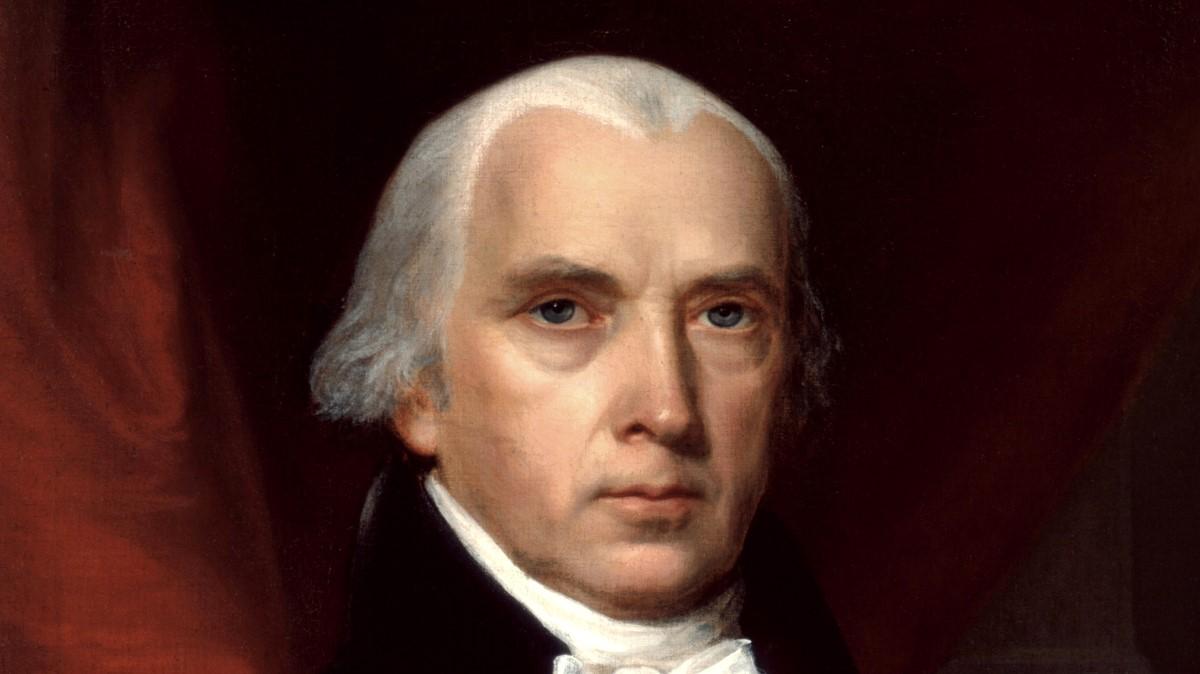
The debate between the Federalists and the Anti-Federalists in the late eighteenth century was fundamentally a debate over whether or not Americans wanted or needed a large national state. Thus, in their effort to push ratification of the new constitution, the Federalists employed a wide variety of arguments designed primarily to convince the public that the United States, as it stood in 1787, was not politically centralized enough.
We often find words like “licentiousness” and “anarchy” used by the Federalists to describe what will afflict the United States if it does not embrace a larger and stronger national government. The Federalists often argued that abuse of power was less of a threat than “too much” freedom and therefore a stronger state is a better guarantor of wealth and order. (The Anti-Federalists, of course, took the opposite position.) Indeed, Madison, in Federalist No. 48, essentially accuses the states of being paranoid about the dangers to liberty posed by a more robust federal regime. Hamilton takes this sneering attitude toward the fears of anti-Federalists to the next level by claiming in Federalist No. 84 that there wasn’t even a need for a bill of rights in the constitution. After all, Hamilton claims, there is no danger of the national government attempting to claim any powers that are not explicitly written into the text. If the term “gaslighting” had existed in the eighteenth century, it would have applied here.
A great many Americans in 1787, however, were generally confident that their own republican constitutions—plus the national constitution already in place—would be sufficient to protect both their liberties and their property. It had only been a few years, after all, since the loose American confederation had defeated the powerful British Empire in a military conflict.
On the other hand, in The Federalist Papers, the federalist spokesmen Madison and Hamilton claimed repeatedly that republics have historically been too often subject to “unceasing agitations,” foreign influence, and “frequent revolutions.” The implication here is that if the Americans do not embrace a much stronger national government, the American republics will end up on the ash heap of ancient and medieval republics which were supposedly both short-lived and uncommonly violent.
This narrative never went away. We see it repeated yet again in a 2020 essay by historian Stephen Klugewicz, editor of The Imaginative Conservative. Klugewicz provides a helpful summary of the Federalist position:
Americans had every reason to be pessimistic about their experiment in republicanism. History taught that republics were inherently unstable and vulnerable to decay. … The histories of the Florentine and Venetian republics of Renaissance Italy too had been glorious but short-lived. Theorists … warned that republics suffer from particular dangers that monarchies and despotisms do not. … Republics were assumed to burn brightly but briefly because of their inherent instability. … One element of society always usurped power and established a tyranny.
But there’s a problem with these claims. They’re not true.
To be sure, European history has experienced many short-lived republics, just as there have been many short-lived kingdoms and principalities. The Kingdom of the Two Sicilies, for example, isn’t exactly known for a long history as a sovereign state.
Moreover, it would be absurd to point to the monarchies of Europe in centuries before the American Revolution as mostly examples of unremitting peace and stability. In many cases, a large “stable” monarchy was simply a state that excelled at putting down rebellions through massacres and torture. They were often regimes, to paraphrase Ronald Hamowy, of “the rack and the thumbscrew.” Any judgement passed on republics in the centuries leading up to the time of the Federalists must be seen in this context.
Not all monarchies were equally despotic, of course, just as not all republics were equally unstable. By the time of the Federalists, Europe had already had its share of republics that provided examples that contradict the popular Federalist notions of all republics being “glorious but short-lived.” Some of these were even important European powers who held their own against some of the most powerful monarchies of the time.
The Venetian Republic
One of the most obvious examples that must be mentioned is the Venetian Republic, which lasted a thousand years and which dominated much of the eastern Mediterranean for centuries. That Klugewicz would list the Republic among “short-lived” polities is nothing short of mystifying. By the 1780s, the Republic was more than 800 years old. It was so old, in fact, that the Republic had gained a reputation for “immortality” due to its remarkable ability to maintain political stability.
Some may claim the Venetian Republic was not really a republic because it was not a liberal republic, and had very few popular elements in its central government. Yet, liberalism and popular elections have never been a requirement for a regime to be considered republican. Even in his denunciation of the Venetians, Hamilton in Federalist No. 6 refers to it as “that haughty republic” for its presumed excessive reliance on a merchant oligarchy. Hamilton’s dismissal of Venice as tyrannical, however, merely reflects the historical mythology of the time, which alternated between views of the Venetians as either remarkably prudent statemen, or as conniving tyrants.
We should not be surprised we get a rather shallow analysis of the Venetians from Hamilton here. The essays in the Federalist Papers were essentially propaganda pieces designed less to inform than to manufacture consent for a new constitution.
For a more reliable view on Venice and other republics of the time, we can look to John Adams’s more serious work A Defense of the Constitutions of Government of the United States of America. Adams would eventually become a Federalist, of course, but when he wrote the Defense, he was writing before the new US constitution was written and was not pushing any particular political agenda. As such, Adams sought to provide a more informational historical analysis of the world’s republics.
So, with Adams, we find a more balanced and sophisticated view of the Venetians. Adams notes Venice was not liberal, but that this “aristocratical republic” was notable for its “sagacity” and a well-established rule of law which contributed to “the long duration of this aristocracy.” Especially notable to Adams was Venice’s use of many layers of checks and balances on the ruling factions to ensure no one group or person could rule through the chief executive known as the “doge.” As twenty-first-century historian Thomas Madden has shown, the Venetian Republic was not quite the despotism it is often assumed to be:
[By the late twelfth century] Venice, the republic where powerful doges ruled powerful people, was becoming something different—a government in which a distinct body of elites …began to draw into themselves the powers of both people and doge. It was not, and never would be, an oligarchy. Rather, the Venetian republic was being outfitted with new bodies and procedures, which ensured that it would act prudently, cautiously, and predictably.
The Dutch Republic
The Venetian example obviously contradicts the myth that republics tend toward internal disorder and collapse. The Venetian polity, however, tells us little about confederations. For those seeking information on more liberal, decentralized republics, however, there is the Dutch Republic. At the time of the ratification debate, the Dutch Republic was more than 200 years old in spite of the immense handicap of sharing a land border with France—the largest military power in Europe.
The Republic was characterized by relatively high levels of religious tolerance, an unusually large amount of economic and political freedom, a high standard of living, and a decentralized political system. Or as, Joop de Jong puts it:
The Dutch Republic adopted a rather atypical form of government. It was neither a city-state like Venice, nor a modern (equating modern with centralization) territorial state, such as France. Instead, the seven United Provinces constituted a confederation without a strong central authority and in which the nobility was less prominent than other elites.
The elites, rather, were largely commercial, bourgeois elites. The central power relied largely on a consensus model, and individual member republics were almost completely free in their own internal affairs. Yet, strangely, James Madison contends in the Federalist No. 20 that the Dutch Republic was a terrible model for the United States, and was marked by “imbecility in the government.” The main problem for Madison? The central government of the Dutch confederation was not nearly strong and centralized enough. For Madison, the fact that the Dutch Republic’s constitution more closely resembled that of the US Articles of Confederation, rather than the new proposed constitution, apparently impelled Madison to wave it aside. Yet, the Dutch “state” had already held its own in a number of military conflicts against major powers, and even in its eighteenth-century period of relative decline, remained one of the most economically vibrant areas of Europe.
For his part, John Adams in his Defense speaks well of the Dutch Republic, listing some of the member republics among the “aristocratical republics” and some among the “democratical republics.” Of course, “democracy” was a relative term, and suffrage was hardly universal. Yet, Adams in the Defense describes the popular elements present in the Republic this way:
With all the sagacity, and more wisdom than Venice or Bern, it has always had more consideration for the people than either, and has given more authority to the first magistrate. It has never had any exclusive preferences of families or nobles. Offices have, by law at least, been open to all men of merit.
The Swiss Republics
Like the Dutch republics, the Swiss republics were also joined together in a confederation. The Swiss however, being largely rural and landlocked during the days of the old confederation, never achieved the commercial success of the Dutch. Nonetheless, the Swiss, in their own way, did manage to illustrate how even a loose confederation of small republics could keep powers like the Habsburgs at bay for centuries.
The Swiss confederation was considerably older than the Dutch, and at the time of the American ratification debate, the confederation had been in existence for more than 400 years.
As with the Dutch model, Adams finds the Swiss model to be a laudable mixture of both democratic and aristocratical republican elements. He concludes that public order is “well regulated … throughout Switzerland” and repeatedly uses the term “liberty” to describe the state of affairs in several of the Swiss republics. He is especially complimentary of the republican government in Glarus of which he states:
[In Glarus,] Liberty does not degenerate into licentiousness. Liberty, independence, and an exemption from taxes, amply compensate for a want of the refinements of luxury. There are none so rich as to gain an ascendency by largesses. If they err in their counsels, it is an error of the judgment, and not of the heart. As there is no fear of invasion, and they have no conquests to make, their policy consists in maintaining their independence and preserving the public tranquillity.
Yet, here again, Madison employs much hand waving to distract readers from an example of the benefits of a decentralized confederation. He claims in Federalist No. 19 that “whatever efficacy the [Swiss] union may have had in ordinary cases, it appears that the moment a cause of difference sprang up, capable of trying its strength, it failed.”
More modern observers, however, have found that the historical record doesn’t quite support Madison’s contempt. For example, historian Andreas Würgler, in attempting to answer the question of how the Swiss Confederation managed to survive for so long, writes:
As a league of republics, the cantons for the most part could avoid the dynastic mechanisms of succession and hereditary wars that plagued much of the rest of early modern Europe. The threat was, nonetheless, that the country would be divided between the great neighbouring countries … European observers were often sceptical about the enigmatic Swiss federalist system. They doubted its ability to establish and maintain order, or as contemporaries used to say, “good policing.” Early modern commentators pointed to the lack of a monarch as an obvious sign of disorder, while today’s historians prefer to emphasise Switzerland’s large number of social conflicts. But the number of domestic conflicts does not necessarily condemn a political system. The number of disputes is less important than how they get resolved. Swiss conflict-management was for the most part characterised as smooth and successful.
The fact that the Confederation was remarkably flexible and adept at handling internal conflicts does not prove it “failed” in periods when conflicts arose. The Swiss, after all, avoided the sort of civil war that destroyed half of the more centralized United States in the nineteenth century. The endurance of the confederation in various forms merely proves the Swiss were skilled at dealing with the unfortunate realities of being sandwiched between the French and the Habsburgs.
The modern, observer, of course, might claim these states were somehow weak because they fell under the military might of the French in the late 1790s. Yet, the fact that the Dutch and the Swiss were subjugated by Napoleon hardly proves anything, as the same was true of every polity—monarchy or not—that shared a land border with France at the time. The same fate would have befallen Madison’s preferred American republic had it been at the same geographic disadvantage.
As to the matter of republican longevity overall, Madison’s more centralized constitution failed to impress. The republic he and Hamilton hammered together required less than a century to descend into a failed state and bloody civil war in 1861. After that, the US was based no longer on the same alleged social contract that had been the basis of the 1787 constitution. The old constitution endures today in a de jure sense only. The post-1861 de facto republic has always been based on military conquest and newly invented “law” by federal judges declaring federal state to no longer be composed of a voluntary union of republics.
Today’s supporters of the Federalist project, however, tend to unquestioningly accept the superficial and dismissive “analysis” of other republics offered in The Federalist Paper by its authors. Hamilton and Madison, however, were likely driven less by a desire for honest inquiry than a desire to get through their political platform of a new centralized national government. That often required painting the proposed constitution in an unjustifiably good light while discounting the proven workability of less centralized federal systems abroad.






